YAMAHA XSR 900 2020 Manual Online
Manufacturer: YAMAHA, Model Year: 2020, Model line: XSR 900, Model: YAMAHA XSR 900 2020Pages: 102, PDF Size: 7.74 MB
Page 81 of 102
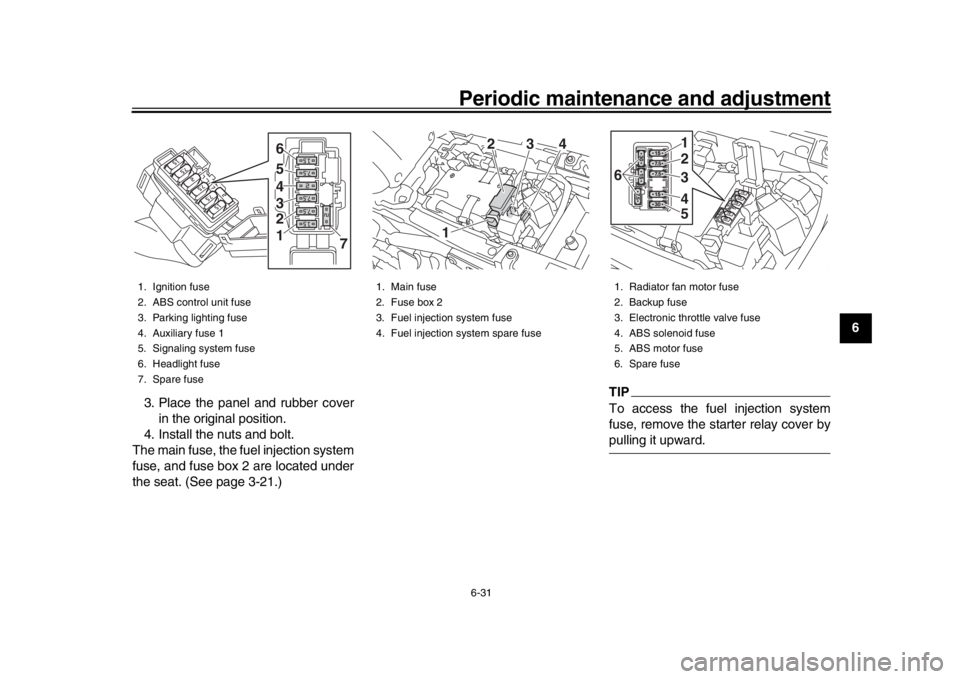
Periodic maintenance and adjustment6-31
1
2
3
4
567
8
9
10
11
12
3. Place the panel and rubber cover
in the original position.
4. Install the nuts and bolt.
The main fuse, the fuel injection system
fuse, and fuse box 2 are located under
the seat. (See page 3-21.)
TIPTo access the fuel injection system
fuse, remove the starter relay cover bypulling it upward.
1. Ignition fuse
2. ABS control unit fuse
3. Parking lighting fuse
4. Auxiliary fuse 1
5. Signaling system fuse
6. Headlight fuse
7. Spare fuse
7
1 2 3 4 5 6
1. Main fuse
2. Fuse box 2
3. Fuel injection system fuse
4. Fuel injection system spare fuse
2
1 3
4
1. Radiator fan motor fuse
2. Backup fuse
3. Electronic throttle valve fuse
4. ABS solenoid fuse
5. ABS motor fuse
6. Spare fuse
15
1515
1
2
34
5
6
BAE-28199-E1.book 31 ページ 2019年8月23日 金曜日 午後3時56分
Page 82 of 102
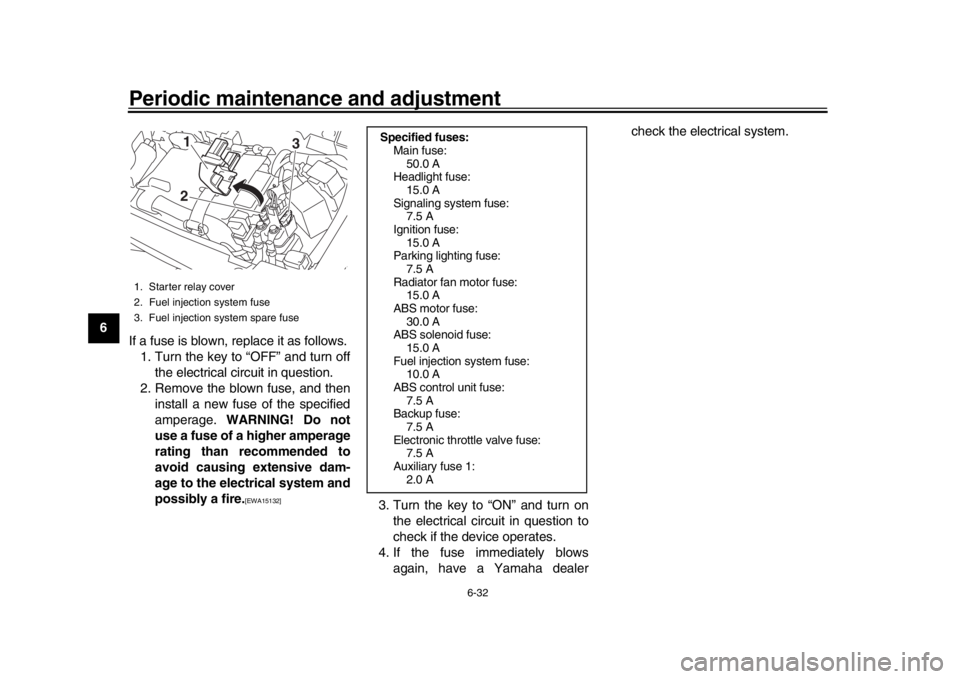
Periodic maintenance and adjustment
6-32
1
2
3
4
56
7
8
9
10
11
12 If a fuse is blown, replace it as follows.
1. Turn the key to “OFF” and turn off the electrical circuit in question.
2. Remove the blown fuse, and then install a new fuse of the specified
amperage. WARNING! Do not
use a fuse of a higher amperage
rating than recommended to
avoid causing extensive dam-
age to the electrical system and
possibly a fire.
[EWA15132]
3. Turn the key to “ON” and turn on the electrical circuit in question to
check if the device operates.
4. If the fuse immediately blows again, have a Yamaha dealer check the electrical system.
1. Starter relay cover
2. Fuel injection system fuse
3. Fuel injection system spare fuse
1
2 3
Specified fuses:
Main fuse:50.0 A
Headlight fuse:
15.0 A
Signaling system fuse: 7.5 A
Ignition fuse: 15.0 A
Parking lighting fuse:
7.5 A
Radiator fan motor fuse: 15.0 A
ABS motor fuse: 30.0 A
ABS solenoid fuse:
15.0 A
Fuel injection system fuse: 10.0 A
ABS control unit fuse: 7.5 A
Backup fuse:
7.5 A
Electronic throttle valve fuse: 7.5 A
Auxiliary fuse 1: 2.0 A
BAE-28199-E1.book 32 ページ 2019年8月23日 金曜日 午後3時56分
Page 83 of 102
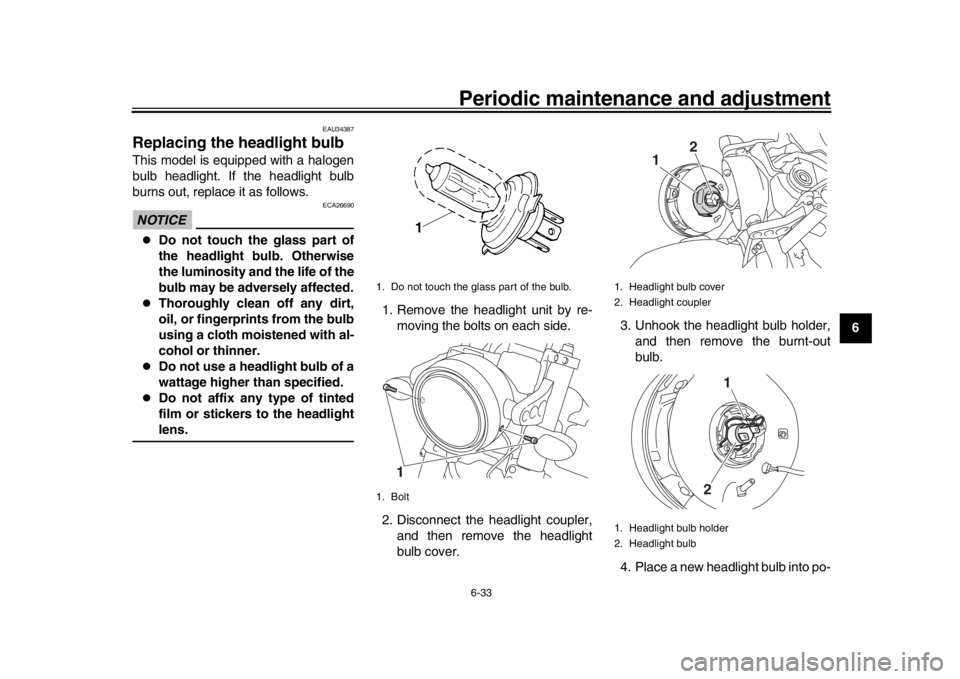
Periodic maintenance and adjustment6-33
1
2
3
4
567
8
9
10
11
12
EAU34387
Replacing the headlight bulbThis model is equipped with a halogen
bulb headlight. If the headlight bulb
burns out, replace it as follows.NOTICE
ECA26690
Do not touch the glass part of
the headlight bulb. Otherwise
the luminosity and the life of the
bulb may be adversely affected.
Thoroughly clean off any dirt,
oil, or fingerprints from the bulb
using a cloth moistened with al-
cohol or thinner.
Do not use a headlight bulb of a
wattage higher than specified.
Do not affix any type of tinted
film or stickers to the headlightlens. 1. Remove the headlight unit by re-
moving the bolts on each side.
2. Disconnect the headlight coupler, and then remove the headlight
bulb cover. 3. Unhook the headlight bulb holder,
and then remove the burnt-out
bulb.
4. Place a new headlight bulb into po-
1. Do not touch the glass part of the bulb.
1. Bolt
1
1. Headlight bulb cover
2. Headlight coupler
1. Headlight bulb holder
2. Headlight bulb
1 2
1
2
BAE-28199-E1.book 33 ページ 2019年8月23日 金曜日 午後3時56分
Page 84 of 102
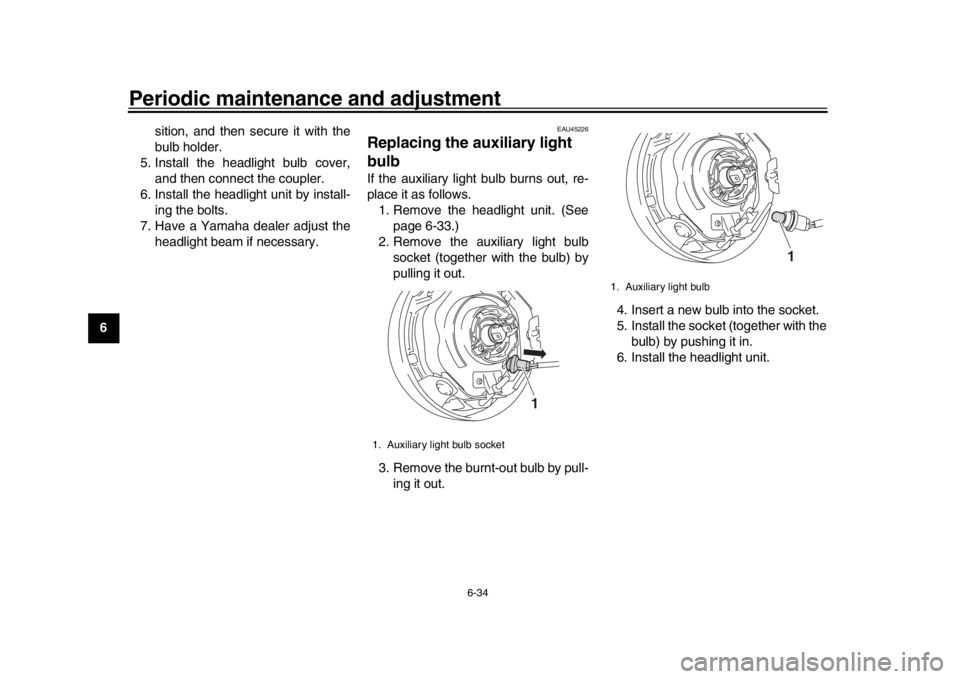
Periodic maintenance and adjustment
6-34
1
2
3
4
56
7
8
9
10
11
12 sition, and then secure it with the
bulb holder.
5. Install the headlight bulb cover, and then connect the coupler.
6. Install the headlight unit by install- ing the bolts.
7. Have a Yamaha dealer adjust the headlight beam if necessary.
EAU45226
Replacing the auxiliary light
bulb If the auxiliary light bulb burns out, re-
place it as follows.1. Remove the headlight unit. (See page 6-33.)
2. Remove the auxiliary light bulb socket (together with the bulb) by
pulling it out.
3. Remove the burnt-out bulb by pull- ing it out. 4. Insert a new bulb into the socket.
5. Install the socket (together with the
bulb) by pushing it in.
6. Install the headlight unit.1. Auxiliary light bulb socket
1
1. Auxiliary light bulb
1
BAE-28199-E1.book 34 ページ 2019年8月23日 金曜日 午後3時56分
Page 85 of 102
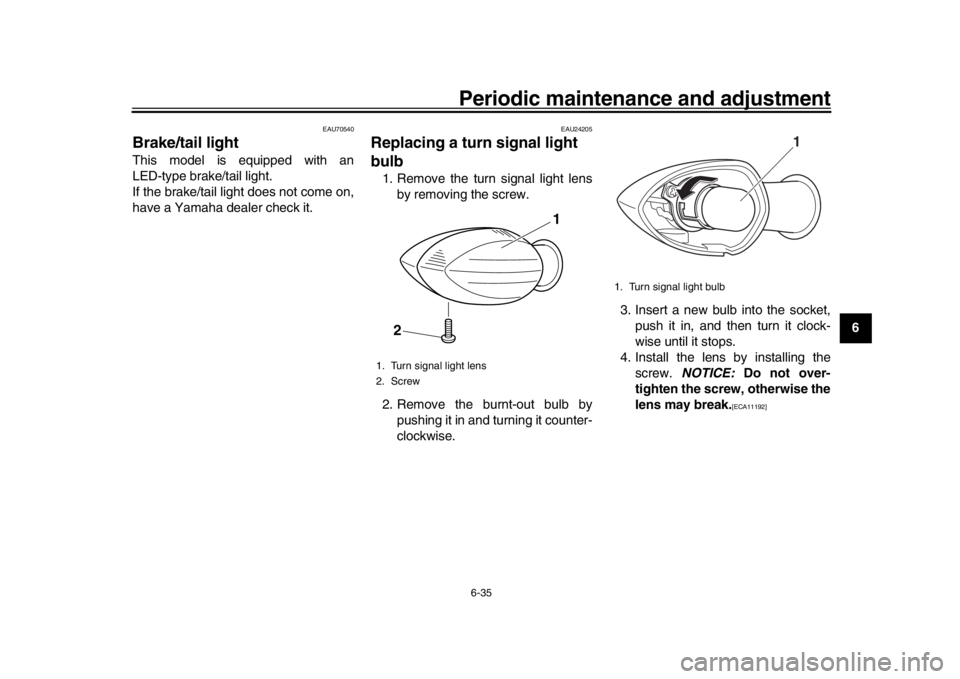
Periodic maintenance and adjustment6-35
1
2
3
4
567
8
9
10
11
12
EAU70540
Brake/tail lightThis model is equipped with an
LED-type brake/tail light.
If the brake/tail light does not come on,
have a Yamaha dealer check it.
EAU24205
Replacing a turn signal light
bulb1. Remove the turn signal light lens by removing the screw.
2. Remove the burnt-out bulb by pushing it in and turning it counter-
clockwise. 3. Insert a new bulb into the socket,
push it in, and then turn it clock-
wise until it stops.
4. Install the lens by installing the screw. NOTICE: Do not over-
tighten the screw, otherwise the
lens may break.
[ECA11192]
1. Turn signal light lens
2. Screw
1
2
1. Turn signal light bulb
1
BAE-28199-E1.book 35 ページ 2019年8月23日 金曜日 午後3時56分
Page 86 of 102
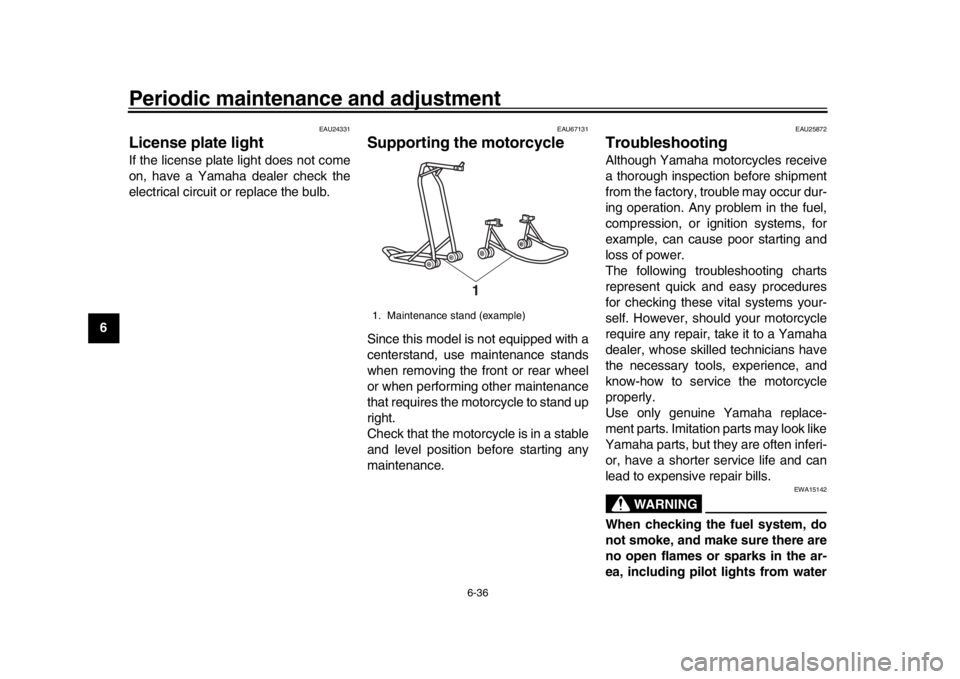
Periodic maintenance and adjustment
6-36
1
2
3
4
56
7
8
9
10
11
12
EAU24331
License plate lightIf the license plate light does not come
on, have a Yamaha dealer check the
electrical circuit or replace the bulb.
EAU67131
Supporting the motorcycleSince this model is not equipped with a
centerstand, use maintenance stands
when removing the front or rear wheel
or when performing other maintenance
that requires the motorcycle to stand up
right.
Check that the motorcycle is in a stable
and level position before starting any
maintenance.
EAU25872
TroubleshootingAlthough Yamaha motorcycles receive
a thorough inspection before shipment
from the factory, trouble may occur dur-
ing operation. Any problem in the fuel,
compression, or ignition systems, for
example, can cause poor starting and
loss of power.
The following troubleshooting charts
represent quick and easy procedures
for checking these vital systems your-
self. However, should your motorcycle
require any repair, take it to a Yamaha
dealer, whose skilled technicians have
the necessary tools, experience, and
know-how to service the motorcycle
properly.
Use only genuine Yamaha replace-
ment parts. Imitation parts may look like
Yamaha parts, but they are often inferi-
or, have a shorter service life and can
lead to expensive repair bills.
WARNING
EWA15142
When checking the fuel system, do
not smoke, and make sure there are
no open flames or sparks in the ar-
ea, including pilot lights from water
1. Maintenance stand (example)
1
BAE-28199-E1.book 36 ページ 2019年8月23日 金曜日 午後3時56分
Page 87 of 102
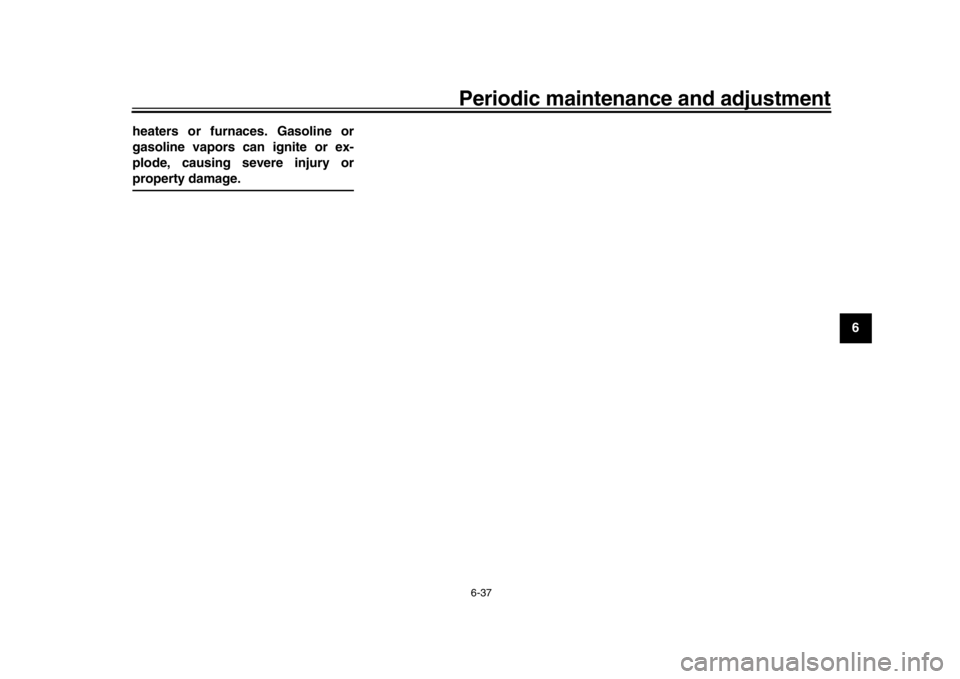
Periodic maintenance and adjustment6-37
1
2
3
4
567
8
9
10
11
12
heaters or furnaces. Gasoline or
gasoline vapors can ignite or ex-
plode, causing severe injury or
property damage.
BAE-28199-E1.book 37 ページ 2019年8月23日 金曜日 午後3時56分
Page 88 of 102
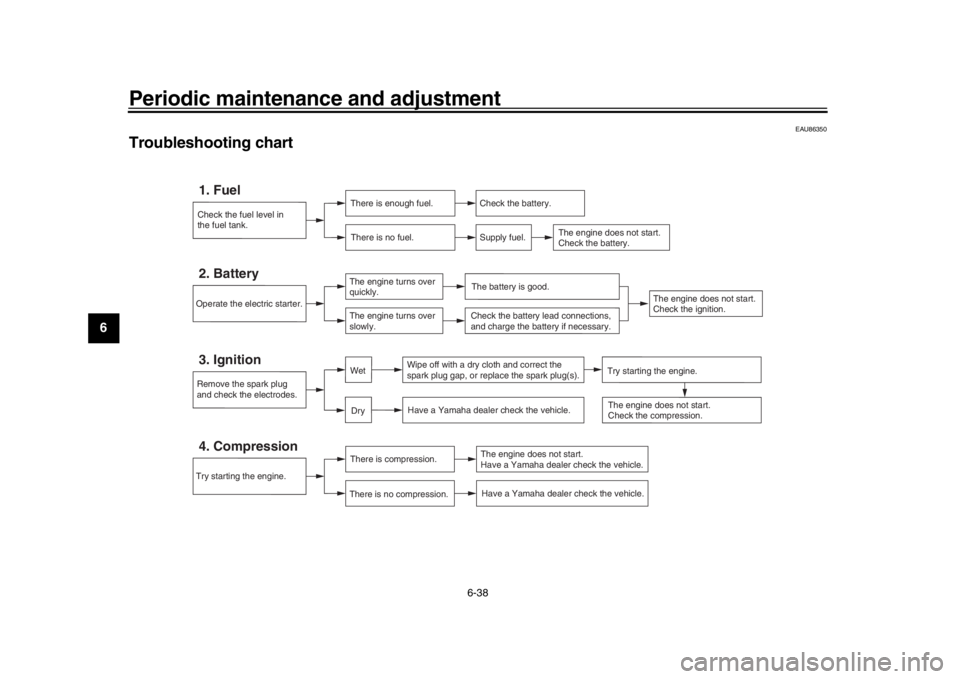
Periodic maintenance and adjustment
6-38
1
2
3
4
56
7
8
9
10
11
12
EAU86350
Troubleshooting chart
Check the fuel level in
the fuel tank.1. Fuel
There is enough fuel.
There is no fuel.
Check the battery.
Supply fuel.
The engine does not start.
Check the battery.
Try starting the engine.4. Compression
There is compression.
There is no compression.
The engine does not start.
Have a Yamaha dealer check the vehicle.Have a Yamaha dealer check the vehicle.
Remove the spark plug
and check the electrodes.3. Ignition
Wipe off with a dry cloth and correct the
spark plug gap, or replace the spark plug(s). Have a Yamaha dealer check the vehicle.
The engine does not start.
Check the compression.
Operate the electric starter.2. Battery
The engine turns over
quickly.
The engine turns over
slowly.
The battery is good.
DryWet
Try starting the engine.
Check the battery lead connections,
and charge the battery if necessary.
The engine does not start.
Check the ignition.
BAE-28199-E1.book 38 ページ 2019年8月23日 金曜日 午後3時56分
Page 89 of 102
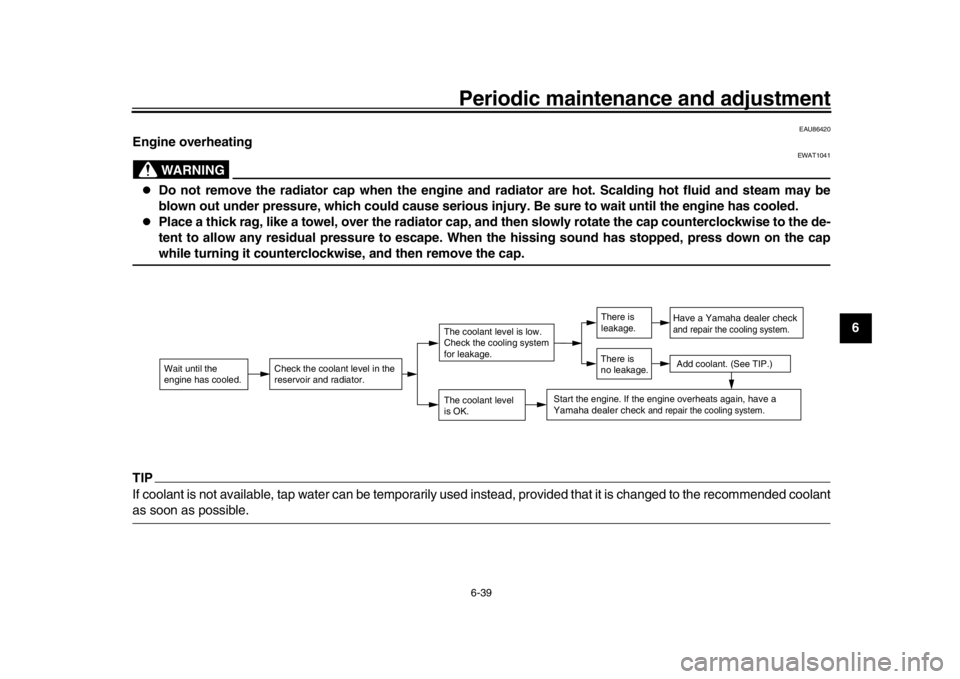
Periodic maintenance and adjustment6-39
1
2
3
4
567
8
9
10
11
12
EAU86420
Engine overheating
WARNING
EWAT1041
Do not remove the radiator cap when the engine and radiator are hot. Scalding hot fluid and steam may be
blown out under pressure, which could cause serious injury. Be sure to wait until the engine has cooled.
Place a thick rag, like a towel, over the radiator cap, and then slowly rotate the cap counterclockwise to the de-
tent to allow any residual pressure to escape. When the hissing sound has stopped, press down on the capwhile turning it counterclockwise, and then remove the cap.
TIPIf coolant is not available, tap water can be temporarily used instead, provided that it is changed to the recommended coolantas soon as possible.
Wait until the
engine has cooled.
Check the coolant level in the
reservoir and radiator.
The coolant level
is OK.The coolant level is low.
Check the cooling system
for leakage.
Have a Yamaha dealer checkand repair the cooling system.Add coolant. (See TIP.)
Start the engine. If the engine overheats again,
have a
Yamaha dealer check
and repair the cooling system.
There is
leakage.
There is
no leakage.
BAE-28199-E1.book 39 ページ 2019年8月23日 金曜日 午後3時56分
Page 90 of 102
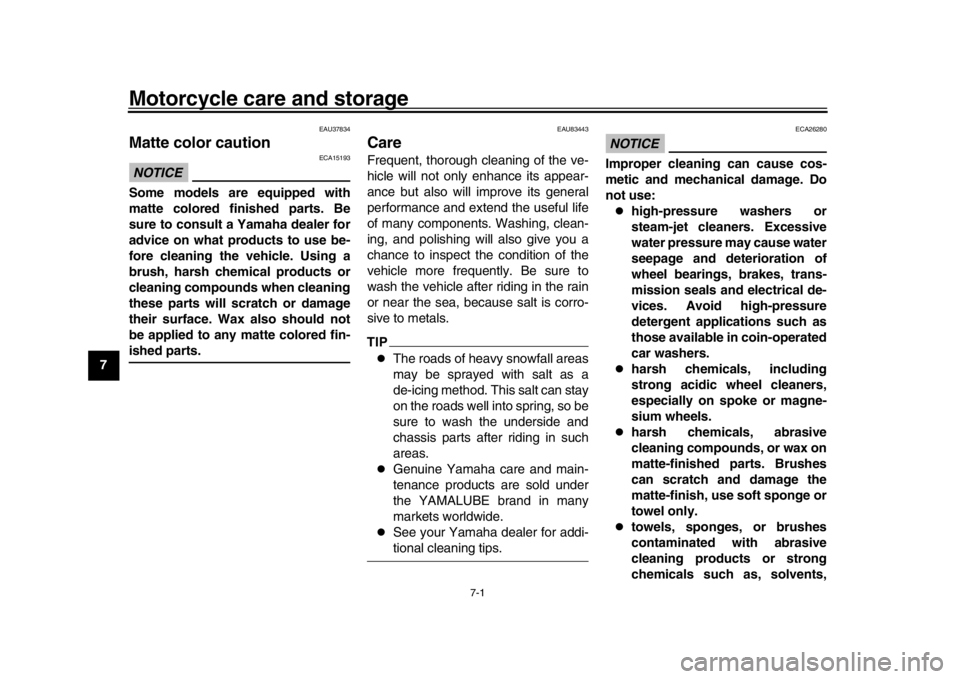
7-1
1
2
3
4
5
67
8
9
10
11
12
Motorcycle care and storage
EAU37834
Matte color cautionNOTICE
ECA15193
Some models are equipped with
matte colored finished parts. Be
sure to consult a Yamaha dealer for
advice on what products to use be-
fore cleaning the vehicle. Using a
brush, harsh chemical products or
cleaning compounds when cleaning
these parts will scratch or damage
their surface. Wax also should not
be applied to any matte colored fin-ished parts.
EAU83443
CareFrequent, thorough cleaning of the ve-
hicle will not only enhance its appear-
ance but also will improve its general
performance and extend the useful life
of many components. Washing, clean-
ing, and polishing will also give you a
chance to inspect the condition of the
vehicle more frequently. Be sure to
wash the vehicle after riding in the rain
or near the sea, because salt is corro-
sive to metals.TIP
The roads of heavy snowfall areas
may be sprayed with salt as a
de-icing method. This salt can stay
on the roads well into spring, so be
sure to wash the underside and
chassis parts after riding in such
areas.
Genuine Yamaha care and main-
tenance products are sold under
the YAMALUBE brand in many
markets worldwide.
See your Yamaha dealer for addi-tional cleaning tips.
NOTICE
ECA26280
Improper cleaning can cause cos-
metic and mechanical damage. Do
not use:
high-pressure washers or
steam-jet cleaners. Excessive
water pressure may cause water
seepage and deterioration of
wheel bearings, brakes, trans-
mission seals and electrical de-
vices. Avoid high-pressure
detergent applications such as
those available in coin-operated
car washers.
harsh chemicals, including
strong acidic wheel cleaners,
especially on spoke or magne-
sium wheels.
harsh chemicals, abrasive
cleaning compounds, or wax on
matte-finished parts. Brushes
can scratch and damage the
matte-finish, use soft sponge or
towel only.
towels, sponges, or brushes
contaminated with abrasive
cleaning products or strong
chemicals such as, solvents,
BAE-28199-E1.book 1 ページ 2019年8月23日 金曜日 午後3時56分